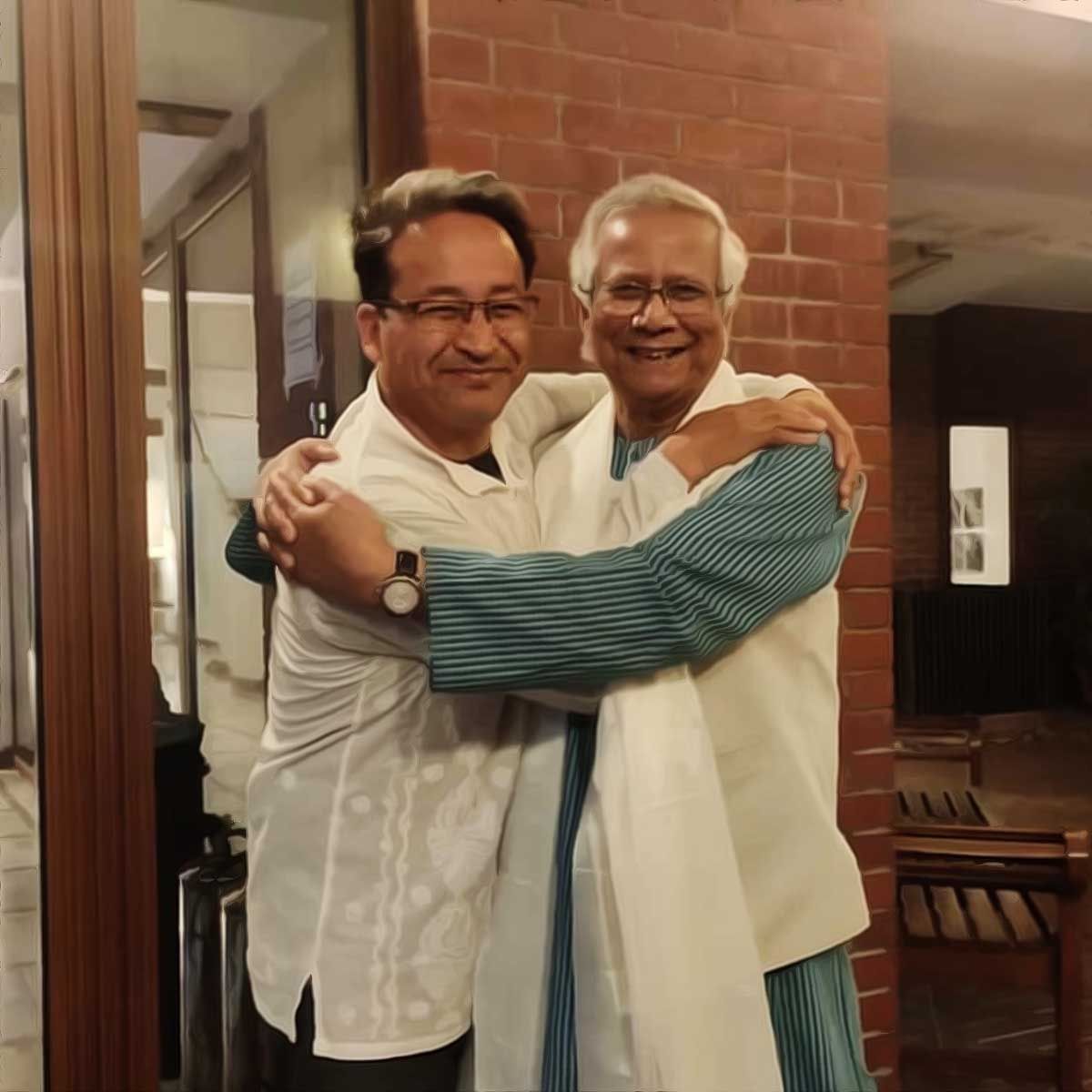More Coverage
Twitter Coverage
Satyaagrah
Written on
Satyaagrah
Written on
Satyaagrah
Written on
Satyaagrah
Written on
Satyaagrah
Written on
JOIN SATYAAGRAH SOCIAL MEDIA
"गुमराह": Sonam Wangchuk, tied to foreign-funded NGOs like Ford & Soros is exposed for blocking thousands of crores in eco-friendly projects in Ladakh, opposing India’s military infrastructure while China develops Aksai Chin. Is his activism aiding China?

You know Sonam Wangchuk, right? The man hailed as the real-life "Phunsukh Wangdu" from 3 Idiots, the climate crusader who marched 1,000 kilometers from Ladakh to New Delhi, supposedly to "save Ladakh's fragile climate." That's what the media fed you. But here’s the twist – what if this wasn’t the whole truth? What if the story behind this environmental hero hides a far more complex, possibly sinister, reality? Buckle up, because what you are about to read could change the way you see Ladakh, Sonam Wangchuk, and even the world's most secretive superpower – China.
|
Ladakh, with an area of 45,000 square miles (about 117,000 square kilometers), stands as India's largest and one of its most sparsely populated regions. While breathtaking in its landscape and cultural richness, it remains one of the most underdeveloped areas in the country. Development has been stunted not just by geographical challenges but also due to political disputes, most notably with China, which occupies a significant portion of the region known as Aksai Chin.
The contrast between India's Ladakh and China's Aksai Chin is stark. On the Chinese side, massive infrastructure projects have been undertaken, making Aksai Chin a key strategic area for Beijing. Roads, military installations, and even settlements have mushroomed there, reflecting China's aggressive development policy. This construction drive is not limited to military logistics; China has built extensive networks of roads and railways in Aksai Chin to ensure strategic and supply chain advantages. Meanwhile, these activities have taken a toll on the fragile environment, accelerating the melting of glaciers and disrupting the local ecosystems. The environmental cost of these developments extends beyond Aksai Chin, affecting the entire Himalayan region’s climate LIFE on the PLANET LADAKH, Biz News & Finance..
India's approach to Ladakh, on the other hand, took a significant turn when the region was reorganized into a Union Territory nearly two years ago. This change brought hopes for rapid development. Sharad Kumar Saraf, the President of the Federation of Indian Export Organisations (FIEO), noted that "Prime Minister Narendra Modi's bold decisions would attract investments" to Ladakh. Saraf believed this move could "open up several sectors with immense potential," such as tourism, renewable energy, horticulture, and food processing, potentially transforming Ladakh's economic landscape Biz News & Finance, mint.
Tourism remains one of the major pillars of Ladakh's economy, blending nature, adventure, and spirituality. With Leh, its largest town situated at an elevation of 11,400 feet, Ladakh's scenic charm attracts travelers from around the globe. The tourism sector not only supports a significant portion of Ladakh's GDP (about 50%) but also creates numerous jobs in related industries such as hotels, catering, and local transport. In 2020, tourism in Ladakh was estimated to be worth approximately INR 600 crore ($84 million) LIFE on the PLANET LADAKH, mint.
The region's diverse landscape includes cold deserts and high-altitude terrains in the Great Himalayan range, drawing both domestic and international tourists. Among the top attractions is Khardung La Pass, the world’s highest motorable pass at 18,350 feet, providing a gateway to the Nubra Valley. The serene Pangong Tso Lake is also a favorite, with its crystal-clear blue waters reflecting the surrounding mountains. Additionally, Ladakh’s cultural heritage is highlighted by numerous monasteries, such as Hemis, Thiksey, and Alchi, which are important pilgrimage sites and historical landmarks Press Information Bureau, Press Information Bureau.
|
Tourism is crucial to the local economy. In 2019, Ladakh recorded 279,937 tourist arrivals, including 38,652 foreign visitors. However, the COVID-19 pandemic hit the sector hard, reducing arrivals to just 6,079 tourists in 2020, with only 1,060 international travelers. To rejuvenate the industry, the Ministry of Tourism launched initiatives such as a webinar titled "Ladakh: Explore the Unexplored", part of the Dekho Apna Desh series, which aims to promote lesser-known destinations across India Ministry of Tourism, The Better India..
Despite its tourism appeal, Ladakh remains ecologically fragile. The region plays a vital role in regulating the climate of the Indian subcontinent due to its glaciers, which are a key water source for many of India's rivers. As such, any significant development requires careful consideration of environmental impacts.
Sonam Wangchuk, the renowned climate activist, has been vocal about the dangers of unregulated development in Ladakh. Known for innovations like the Ice Stupa and his sustainable education models, Wangchuk recently walked 1,000 kilometers from Ladakh to New Delhi to bring attention to climate change. However, some claim that his activism could inadvertently align with China's strategic interests by discouraging India's infrastructure expansion in border regions like Ladakh, contrasting sharply with Beijing’s aggressive development of Aksai Chin mint, Press Information Bureau, The Better India.
While Sonam Wangchuk is often portrayed as the messiah of environmental activism in Ladakh, raising awareness about the region’s fragile ecosystem, there’s a darker irony here. As Wangchuk passionately waves the flag of "Save Ladakh," could it be that his crusades also serve other agendas? Those whispers in the wind suggest a curious alignment between his efforts and China’s vested interests in keeping India’s northern frontier sparsely populated. After all, why develop Ladakh when you can have an environmentalist do Beijing’s work for you?
A clear comparison exists between Ladakh and Aksai Chin. Both regions share unforgiving climates and rugged terrains. Yet, while Ladakh remains a land of tranquil landscapes, Aksai Chin has undergone a metamorphosis, emerging as a Chinese fortress complete with military outposts, strategic roadways, and advanced infrastructure. The eight hydropower projects recently sanctioned in Ladakh (with a combined capacity of 144 MW) could mark a turning point—if they manage to get off the drawing board, unlike Wangchuk’s perpetual "save the glaciers" narrative. The projects cleared in January 2021 by the Central Water Commission include five sites in Leh (Durbuk Shyok, Nimu Chilling, Shankoo, Ratan Nag, and Rongdo) and three in Kargil (Mangdum Sangra, Kargil Hunderman, and Tamasha) Hindustan Times, World Energy, Home.
.These initiatives seek to balance energy needs while honoring the Indus Waters Treaty. But as India's wheels of progress turn at a glacier's pace, China's bulldozers hum smoothly across Aksai Chin, creating a network that could make Ladakh seem like a protected nature reserve rather than a strategic asset.
Ladakh is blessed with significant renewable energy resources, enjoying about 320 sunny days per year and an impressive solar radiation level of 2022 kWh/m²/annum. This makes it one of the prime locations in India for solar energy development. Additionally, the region's unique geography supports wind energy potential, with an estimated 5 GW of wind power capacity due to favorable wind patterns in its valleys pv magazine International, NIWE.
|
The development of Ladakh's energy sector is moving forward with ambitious plans. In 2023, the Union Budget allocated Rs. 37.05 crore (approximately $4.5 million) for civil aviation projects in Ladakh, aiming to improve connectivity. Simultaneously, the Ministry of Civil Aviation invested Rs. 480.33 crore (around $57.53 million) to upgrade the Leh Airport, a significant step toward enhancing tourism and accessibility CEEW, PV Tech.
Strategically, infrastructure projects are underway to bolster India's presence in the region. A road connecting Chushul to Demchok is under construction along the Line of Actual Control (LAC), facilitating troop movement and supply logistics in eastern Ladakh, which is critical given the ongoing tensions with ChinaScroll.in, PV Tech.
Efforts to support agriculture through the "Per Drop More Crop" scheme provided Rs. 1 crore (around $119,755) in central assistance to promote water-efficient farming. Furthermore, the region saw the establishment of 1,006 industrial units with a combined investment of Rs. 122.71 crore (approximately $14.69 million) Scroll.in.
In renewable energy, the Union Cabinet approved a 13,000 MW project, including a 12,000 MWh Battery Energy Storage System (BESS). Additionally, the construction of the 4.1 km Shinkun La tunnel on the Nimu-Padam-Darcha road, expected to be completed by December 2025 at a cost of Rs. 1,681 crore (about $205.1 million), aims to ensure all-weather access to Ladakh's border areas pv magazine International, CEEW, Scroll.in, pv magazine International, CEEW, Scroll.in, CEEW Insights, and Scroll.
In May 2023, the central government approved the Revamped Distribution Sector Scheme (RDSS) for Ladakh, with a sanctioned cost of Rs. 687.05 crore (US$ 83.8 million). The scheme is designed to improve the power distribution infrastructure across the region, including grid connectivity for Changthang, development of downline infrastructure in Zanskar, and various loss reduction measures in Leh and Kargil districts. The aim is to enhance operational efficiency and reduce power losses, which will support residential life and facilitate industrial growth in the area. The project will be managed by WAPCOS, a government-owned consultancy, appointed as the project management agency for implementation Ladakh Government, Outlook India, Saur Energy International.
In healthcare, Ladakh is set for a major boost with the approval of a medical college in Leh, announced in July 2022 by the Union Ministry of Health and Family Welfare. The project, with an estimated cost of Rs. 325 crore (US$ 39.7 million), is funded on a 90:10 cost-sharing basis between the Central Government and the Union Territory Administration. This institution is expected to improve healthcare access while providing education opportunities for aspiring doctors in the region Business News India.
|
Further economic development is anticipated through a proposed industrial development scheme worth Rs. 3,500 crore (US$ 427 million), aimed at creating job opportunities in the private sector across Ladakh. The initiative could significantly boost employment and stimulate long-term economic growth Outlook India. .
In renewable energy, an additional 20,000 acres of land was allocated in November 2021 for a massive 10 GW energy park in Ladakh. Meanwhile, a Memorandum of Understanding (MoU) signed in February 2021 between the Oil and Natural Gas Corporation (ONGC) and the Ladakh administration plans to tap into the region’s geothermal potential. The geothermal project, expected to unfold in three phases, will start with a 1 MW pilot plant and potentially expand to a 200 MW commercial facility Saur Energy International, Ladakh Government.
Connectivity has been a major focus of Ladakh's development. In June 2020, the government set a goal to achieve 100% telecom connectivity across the region, including remote areas. This ambitious initiative is being executed by Bharat Sanchar Nigam Limited (BSNL), utilizing the Universal Service Obligation Fund (USOF) to extend digital services to even the most isolated villages. The efforts started earlier, with Bharti Airtel rolling out 4G and 2G networks to 26 villages in February 2020, introducing mobile broadband to high-altitude communities for the first time India Brand Equity Foundation, Tele.net.
Further supporting infrastructure development, a Memorandum of Understanding (MoU) was signed between NITI Aayog and the UT administration of Ladakh in January 2020. This agreement aims to boost key sectors like tourism and solar energy by leveraging public-private partnerships, as part of the Development Support Services to States for Infrastructure Projects (D3S-i) initiative India Brand Equity Foundation, India Brand Equity Foundation.
Efforts to improve power supply have also progressed. In May 2021, the central government approved an intra-state transmission project, valued at Rs. 1,309.71 crore (US$ 179.51 million), to connect remote villages to the power grid. This project aims to provide reliable electricity across Ladakh, reaching even the most challenging terrains India Brand Equity Foundation, India Brand Equity Foundation.
|
The Border Roads Organisation (BRO) has been pivotal in enhancing road connectivity. In October 2021, it announced five major road projects to improve access within Ladakh. A groundbreaking achievement was the construction of the world's highest motorable road at 19,300 feet in August 2021, significantly boosting tourism and economic potential in the region India Brand Equity Foundation.
Additionally, in June 2021, Defence Minister Raj Nath Singh inaugurated 11 new bridges, which play a crucial role in linking border areas and supporting strategic needs along Ladakh's borders India Brand Equity Foundation, India Brand Equity Foundation.
In July 2021, the Union Cabinet approved the establishment of an Integrated Multipurpose Corporation for Ladakh, designed to promote socio-economic development in the region. This corporation aims to enhance sectors like industry, tourism, transport, and the marketing of local products. With an authorized share capital of Rs. 25 crore, it will serve as the primary agency for infrastructure development in the Union Territory. The initiative is expected to generate employment and contribute to Ladakh's integrated growth, aligning with the goals of the Atmanirbhar Bharat campaign Prime Minister of India, Press Information Bureau.
Energy efficiency remains a priority in Ladakh's development. In June 2021, Convergence Energy Services Limited (CESL) signed agreements to implement programs for energy-efficient solutions and solar projects, with the goal of making Ladakh a carbon-neutral region. One major project is the 50 MW solar storage plant in collaboration with the Solar Energy Corporation of India (SECI), aimed at ensuring a stable power supply for Leh, thereby enhancing the region's energy self-sufficiency India Brand Equity Foundation, Press Information Bureau.
Efforts to support youth development included the establishment of a Center of Excellence and Wellness by the Indian Army and Hindustan Petroleum Corporation Limited (HPCL) in April 2021, focusing on coaching young Ladakhis for medical and engineering entrance exams. This initiative is part of broader efforts to develop human resources in the region India Brand Equity Foundation.
Additionally, TRIFED launched the Van Dhan Vikas Kendra (VDVK) program in June 2021, operationalizing 10 VDVK clusters to promote local tribal enterprise and sustainable development India Brand Equity Foundation.
Ladakh's geothermal energy potential is also being tapped. In the Puga Valley, ONGC is developing India's first geothermal energy plant, which will begin with a 1 MW pilot project and could eventually expand to a 100 MW capacity, depending on the results of further exploration. The area is known for geothermal activity due to the tectonic plates' collision beneath the region, making it a suitable site for zero-carbon energy development India Brand Equity Foundation, Press Information Bureau.
|
NTPC's Next Big Leap in the Green Hydrogen Space
NTPC Ltd, India's largest power producer and a central public sector undertaking under the Ministry of Power, has embarked on an ambitious project to support Ladakh's journey towards carbon neutrality. This effort includes a trial run of a hydrogen bus in Leh, which began when the first bus arrived on August 17, 2023. The project is part of a larger Green Hydrogen Mobility initiative aimed at deploying five hydrogen fuel cell buses on Leh's intracity routes. In addition, NTPC is setting up a hydrogen fueling station and a 1.7 MW solar plant at an altitude of 11,562 feet, providing renewable power to support the initiative. The buses will undergo a three-month field trial, including roadworthiness tests and other assessments NTPC Limited, Business News India.
The project represents India's first deployment of hydrogen buses in public transport, designed to withstand sub-zero temperatures and low-oxygen conditions typical of high-altitude regions like Leh. NTPC's broader goal is to achieve 60 GW of renewable energy capacity by 2032, incorporating green hydrogen and other sustainable energy technologies SolarQuarter, Indian Chemical News.
|
Lithium Reserves in Jammu and Kashmir
In February 2023, the Geological Survey of India (GSI) announced a significant discovery of 5.9 million tonnes of inferred lithium resources in the Salal-Haimana area of Reasi district, Jammu and Kashmir. This find is the first of its kind in India and places the country among the top seven lithium resource holders globally, which is a crucial development for electric vehicle battery production and other clean technologies. The lithium discovered is classified as G3 inferred resources, indicating an early stage of exploration. Following the discovery, the GSI plans further assessments to evaluate the full potential of lithium in the area, potentially boosting India's ambitions in the electric mobility sector Business Today, Press Information Bureau.
Nitin Gadkari Approves 29 Ladakh Road Projects Worth Rs 1170.16 Crore
On December 29, 2023, Union Road Transport and Highways Minister Nitin Gadkari approved 29 road projects in Ladakh, with a combined investment of Rs 1170.16 crore. These projects aim to develop state highways and district roads, significantly enhancing the region's infrastructure. In addition to road construction, Rs 181.71 crore has been allocated for the construction of eight bridges under the Central Road and Infrastructure Fund (CRIF) scheme for the financial year 2023-24. These efforts are expected to improve connectivity to remote villages, bolster access to strategic areas, and stimulate economic growth, particularly in agriculture and tourism India Today, Press Information Bureau.
|
Interval - The show begins now
Till now, if you've been paying close attention, you must have noticed the pattern: the Government of India is pouring thousands of crores into Ladakh, executing projects that are all eco-friendly and green – hydropower, solar power, geothermal energy, and green hydrogen. These initiatives are transforming Ladakh into a hub of sustainable development. But as history shows, whenever there's a massive development push in India, particularly in sensitive regions, a familiar script begins to unfold. Here, where India is determined to ensure that Ladakh doesn’t just remain a ruggedly beautiful landlocked frontier but becomes a powerhouse of green innovation, a new character emerges – Sonam Wangchuk.
The media loves to paint Wangchuk as a lone environmental warrior, the very "Phunsukh Wangdu" from 3 Idiots who’s single-handedly saving Ladakh from the scourge of development. But is this environmental savior really the only story here? Or is he, knowingly or unknowingly, a perfect puppet in a larger geopolitical theater where China would love nothing more than to see India’s border regions remain underdeveloped and vulnerable? As Ladakh starts to shine with India’s massive investments, Wangchuk has been at the forefront of campaigns raising alarms about so-called "climate threats" whenever new projects are announced. He advocates for restrictions on development under the guise of "saving Ladakh’s fragile ecosystem." But strangely enough, these very same arguments conveniently align with Beijing’s strategic interests in the region.
Yes, you read that right. While India is striving to fortify its northern frontier with smart, green infrastructure, Wangchuk’s activism seems oddly tailored to discourage infrastructural growth. With every call for a ban on mining, curbing road construction, or halting energy projects, Wangchuk is effectively advocating for India to keep Ladakh economically stagnant. And meanwhile, just across the border, China’s Aksai Chin is bustling with new infrastructure, military installations, and state-of-the-art roads. Do you really think Beijing would want Ladakh to catch up?
We've seen this play out before – from the Narmada Dam protests to the Tuticorin industrial shutdown. And what often emerges from the shadows? The arrival of a foreign-funded, Magsaysay Award-winning activist. A figure who steps in, not to advance development, but to bring it to a screeching halt. Suddenly, the narrative shifts. Projects that promise growth and progress become "threats" that need to be thwarted.
|
Enter the Ladakh saga's own activist – Sonam Wangchuk. With a region long overlooked now witnessing a surge in development, the timing of these objections seems almost too convenient. Just as Ladakh is poised for transformation, calls to put the brakes on progress grow louder. On January 26, 2023, Wangchuk launched his first hunger strike, with demands aimed at "protecting Ladakh’s environment" from large-scale projects. But one can't help but wonder: Is this really about environmental preservation, or is there another agenda in play? As development accelerates, so does the resistance. It's almost as if the region's growth itself has become the true target, with Wangchuk's hunger strike marking the beginning of a movement to stifle Ladakh’s potential under the guise of protecting nature mint, Hindustan Times.
After his initial protest, Wangchuk took center stage again in March 2024, this time with a 21-day hunger strike, raising more contentious demands:
- Stop all developmental projects in Ladakh – effectively halting the eco-friendly initiatives being implemented.
- Include Ladakh under the Sixth Schedule of the Indian Constitution – a move that raises significant questions about its implications.
So, what exactly is the Sixth Schedule? Initially designed for northeastern states, the Sixth Schedule grants autonomous powers to tribal areas through the formation of Autonomous District Councils, which have legislative and administrative control over regional matters. This setup allows local bodies to decide on land use, resource management, and developmental projects. If Ladakh were added to the Sixth Schedule, the central government would need local council approval for any new initiative Global Human Rights Defence, Rediff.
While the Sixth Schedule has been effective in protecting the rights and cultures of tribal communities in the northeast, its application to Ladakh presents different challenges. The region already enjoys special status as a Union Territory, and adding it to the Sixth Schedule could create additional hurdles for executing large-scale projects. Essentially, it would pump the brakes on the thousands of crores being invested in renewable energy and infrastructure, requiring local bodies to approve initiatives that might not align with the central government's development vision mint, Global Human Rights Defence.
|
Wangchuk’s push for including Ladakh under the Sixth Schedule seems more than just a quest for tribal autonomy. It appears to be an effort to shift decision-making power to a handful of local authorities, potentially complicating projects under the banner of "protecting local interests." This shift transforms the story from one of swift, eco-friendly development to a bureaucratic labyrinth, where every project requires negotiations, potentially stalling progress Global Human Rights Defence.
Sonam Wangchuk’s activism follows a path that raises several questions. When his initial January 2023 hunger strike in Ladakh didn’t gain much traction, he soon took his demands to Delhi, even staging a dramatic 1,000-kilometer walk. Now, backed by a group of activists in the capital, Wangchuk calls for a complete halt to infrastructure projects in Ladakh. However, his reasoning seems inconsistent and even questionable Hindustan Times, Rediff.
Take his claim that solar power projects in Ladakh would harm the region's renowned pashmina wool industry, potentially costing India valuable foreign exchange. On closer inspection, this argument doesn’t hold up. Solar plants are generally located on barren land, which isn’t suitable for grazing pashmina goats or other agricultural activities. In fact, the vast, uninhabited lands of Ladakh are ideal for solar energy projects precisely because they do not interfere with traditional crafts or farming. So, the question remains: is Wangchuk truly trying to protect pashmina, or is he trying to block renewable energy development in the region?mint, Rediff..
Another curious point is Wangchuk's assertion that Ladakh’s land shouldn’t be used to generate electricity for the comfort of cities like Delhi. This is perplexing because, not too long ago, he was a vocal supporter of solar energy in Ladakh. He even showcased his solar-powered campus in a YouTube video, promoting renewable energy as essential for the region’s self-sufficiency. What changed between then and now? Why would a once-passionate advocate for solar energy suddenly turn against the projects he once championed?
China’s vested interest in keeping India’s development in Ladakh stagnant is well-documented, especially considering its own rapid infrastructure growth in Aksai Chin. The delay or obstruction of India’s projects would undoubtedly benefit Beijing's strategic interests. Likewise, the involvement of foreign-funded NGOs in supporting environmental activists under the guise of “protecting nature” isn’t unprecedented.
|
Sonam Wangchuk’s background is more intricate than the image of a "real-life Phunsukh Wangdu" often portrayed in the media. His father, Sonam Wangyal, was a Congress leader and minister in the Jammu and Kashmir state government, indicating Wangchuk's privileged position in Ladakhi society. This background contrasts sharply with the film’s depiction of a humble gardener's son. Wangchuk’s activism dates back to the 1988 founding of SECMOL (Students' Educational and Cultural Movement of Ladakh), and the 1995 launch of Operation New Hope, an initiative aimed at educational reforms in Ladakh. His projects have consistently received significant funding from organizations like the Ford Foundation, Tata Trust, DanChurchAid, and Karuna Trust, which raises questions about the deeper motivations behind his activism, particularly given the involvement of foreign funding Secmol, India CSR.
Adding complexity to Wangchuk’s story is his relationship with Rebecca Norman, an American woman he met in the late 1980s or early 1990s and reportedly married in 1996. Norman studied at the School for International Training (SIT) and Harvard University, institutions that have connections to prominent funding organizations, including the Ford Foundation, George Soros's Open Society Foundations, and the Bill & Melinda Gates Foundation. While there is little public information about their current relationship, the influence of Norman's background and affiliations may provide context to Wangchuk's activism aligning with global educational and environmental agendas. Notably, Rebecca is known for supporting Joe Biden and being critical of Donald Trump, indicating a specific political orientation that might reflect or influence the causes promoted by Wangchuk YouTube, Unroll.me.
Wangchuk’s recent stance against solar power projects in Ladakh, citing threats to the pashmina wool industry, is inconsistent with his earlier advocacy for renewable energy. He previously championed solar solutions and even showcased SECMOL's solar-powered campus. The shift in his narrative, which now opposes the very initiatives he once supported, coincides with rising international interest in Ladakh’s strategic importance. These inconsistencies raise questions about whether his motivations are influenced by foreign interests aiming to keep Ladakh underdeveloped, ultimately benefiting China and other external actors who prefer a non-industrialized buffer in India’s border regions Unroll.me, India CSR.
After marrying Rebecca Norman, Sonam Wangchuk's links with foreign organizations became more pronounced. Rebecca, who studied at the School for International Training (SIT) and Harvard University, is involved in educational work at SECMOL. SIT, where Rebecca studied, is known to have received funding from significant global foundations like the Ford Foundation, George Soros's Open Society Foundations, and the Bill & Melinda Gates Foundation, which often support social and environmental initiatives globally LSE Research Online, Secmol.
In 2002, Wangchuk was awarded the Ashoka Fellowship, a recognition supported by philanthropic entities like the Skoll Foundation, Schwab Foundation, and Rockefeller Foundation. These organizations are well-known for funding social entrepreneurship, community development, and educational reforms. Wangchuk's association with Ashoka marked the beginning of substantial foreign backing for his projects Wikipedia.
|
His deeper involvement with the Indian government began during the Congress-led UPA administration when he was appointed to various national and regional roles. In 2004, he was part of the Drafting Committee for the Ladakh Hill Council’s Vision Document "Ladakh 2025", which focused on education and tourism. This role was officially acknowledged by Prime Minister Manmohan Singh in 2005, indicating Wangchuk’s closer ties with the government during this period. Additionally, in 2005, he joined the National Governing Council for Elementary Education, further integrating his influence into the realm of educational policy Wikipedia.
From 2007 to 2010, Wangchuk expanded his international affiliations by working as an education advisor for the Danish NGO Mellemfolkeligt Samvirke, which collaborated with India’s Ministry of Education on reforms. His involvement during the Congress regime, particularly under Sonia Gandhi's influence, reflected his strong connections with both domestic and international circles of support LSE Research Online.
Rebecca Norman continues to play a role at SECMOL, serving as a volunteer coordinator and educator. The couple’s work in Ladakh includes training students in practical skills such as renewable energy management, tourism services, and ecological conservation, shaping SECMOL’s holistic approach to education and sustainable living Secmol, LSE Research Online.
3 Idiots and Sonam Wangchuk: Uncovering the Connections
The movie 3 Idiots (2009), directed by Rajkumar Hirani, captivated audiences with its portrayal of the struggles faced by engineering students in India. While the story was largely inspired by Chetan Bhagat’s novel Five Point Someone, the character of Phunsukh Wangdu, played by Aamir Khan, was said to be loosely based on Sonam Wangchuk. Wangchuk's work in Ladakh, particularly in education and innovative learning techniques, was cited as an inspiration for the film. However, Wangchuk clarified that the movie was not a biopic and significantly diverged from his personal experiences Wikipedia, Queen Elizabeth Prize for Engineering.
|
Rise in International Recognition and Awards
Sonam Wangchuk’s international acclaim began to grow rapidly after 2016, with a series of prestigious awards. He received the Fred M. Packard Award for his efforts in environmental conservation from the International Union for Conservation of Nature (IUCN), an organization based in Switzerland and supported by the Rockefeller, Pew, and Packard foundations. The backing from these globally influential entities often brought scrutiny, as some questioned whether their support came with certain expectations or agendas LSE Research Online, Queen Elizabeth Prize for Engineering.
In 2017, Wangchuk was honored with the T.N. Khoshoo Memorial Award, which was funded by the Ford Foundation, an organization with a history of involvement in global advocacy. This award further linked him with international institutions known for pushing specific socio-political causes LSE Research Online.
The most notable recognition Wangchuk received was the Ramon Magsaysay Award in 2018, often dubbed as Asia’s Nobel Prize. However, the Magsaysay Award has a controversial history, with some alleging it has connections to U.S.-aligned interests. The award's selection process, influenced by historical associations with the Ford Foundation and rumors of CIA links during the Cold War, has raised concerns about the motivations behind promoting specific figures for the award. Critics argue that such recognitions could be used to further agendas under the guise of honoring social contributions Wikipedia, Queen Elizabeth Prize for Engineering..
Playing into the Hands of the Deep State and Congress
The rise of Sonam Wangchuk as a prominent figure, with a narrative woven around his contributions to education and environmental activism, seems to have been supported by well-placed connections and strategic endorsements. His background in Ladakh, including the influence of his father, Sonam Wangyal, a Congress leader, gave him a significant social and political edge. This affiliation with Congress, combined with the consistent support from foreign foundations, points to a broader network of backing that aligns with global advocacy movements often critical of India’s development policies.
Wangchuk’s association with the Congress-led UPA government grew apparent when he was appointed to key positions, such as the Drafting Committee for the Ladakh Hill Council’s Vision Document "Ladakh 2025" and the National Governing Council for Elementary Education under the Ministry of Human Resource Development. These roles allowed him to influence educational policies at both regional and national levels during the Congress administration Wikipedia, Queen Elizabeth Prize for Engineering.
In addition, his work with Mellemfolkeligt Samvirke, a Danish NGO, as an education advisor between 2007 and 2010, further cemented his international ties. This collaboration with foreign organizations during a time of Congress governance under Sonia Gandhi's influence suggests that his initiatives had strong backing from both domestic and international sources, potentially facilitating a narrative that resonated with global networks LSE Research Online, Secmol.
|
Support for Anti-India Forces
The affiliations and funding sources tied to Wangchuk’s awards and projects have led some to question whether his activism aligns with foreign interests that may not always favor India's development goals. The Ford Foundation and other international organizations that have historically supported his work are known for promoting specific environmental and educational agendas. Some argue that such agendas may not always prioritize India's strategic interests, particularly in border regions like Ladakh, where development plays a crucial role in national security.
Connections with NGOs and Policy Influence in India
Sonam Wangchuk's network of support extends beyond individual accolades to include his associations with various NGOs, many of which receive foreign funding. He has been connected with LEAD India, a leadership program supported by the Ford Foundation, which has historically been linked to international advocacy groups. Additionally, he has been involved with the International Association for Ladakh Studies (IALS), an organization known for publishing materials on Ladakhi culture, also funded by the Ford Foundation. The consistency of backing from these foreign institutions raises questions about the extent of international influence on his activism and policy positions in India Wikipedia, Ladakh Studies Association.
Changing Stance on Article 370
Wangchuk's position on Article 370, which granted special status to Jammu and Kashmir, initially appeared supportive of its abrogation when the Union Territory of Ladakh was formed. However, over time, his stance evolved, with growing concerns about the impact of the new administrative changes on Ladakh's future. He expressed apprehension about potential overdevelopment and the risk of local communities losing control over their land and resources. These comments were eventually picked up by Pakistan, using his concerns to criticize India's policies in the region, illustrating how Wangchuk's statements could be co-opted to serve anti-India narratives Vivekananda International Foundation, National Herald.
|
The Ice Stupa Controversy
Wangchuk's Ice Stupa project has garnered international attention for its innovative approach to addressing water scarcity in Ladakh by creating artificial glaciers. While the project has been praised for its ingenuity, it has also faced criticism from some local farmers who claim that diverting water for the Ice Stupas deprives downstream farms of much-needed winter water for recharging groundwater. For instance, tensions have arisen between the communities of Phyang, which benefits from the Ice Stupas, and Phey, which experiences reduced water flow. This controversy reflects the mixed reception of Wangchuk's initiatives within the local community, raising questions about whether his solutions are truly sustainable for all residents Vivekananda International Foundation.
Opposing Military Infrastructure Development
Wangchuk has also voiced opposition to certain military construction activities in Ladakh, citing environmental concerns about the impact on the region's fragile ecosystem. However, his stance has sparked debate, as many argue that the strategic importance of military infrastructure in Ladakh is critical given the ongoing tensions along the Line of Actual Control (LAC) with China. Critics contend that prioritizing environmental considerations over national security in such a sensitive border region could weaken India's defensive capabilities National Herald.
These aspects of Wangchuk's activism, from his NGO connections to his shifting views on development and strategic infrastructure, contribute to a complex picture. His activities appear to be influenced by various factors, including foreign funding and evolving political dynamics, which sometimes align with narratives that could undermine India's developmental and security objectives.
 |
Sources:
Ministry of Tourism
The Better India
National Herald
Vivekananda International Foundation
Ladakh Studies Association
IALS
Hindustan Times
World Energy
NDTV,
World-Energy.
 Support Us
Support Us
Satyagraha was born from the heart of our land, with an undying aim to unveil the true essence of Bharat. It seeks to illuminate the hidden tales of our valiant freedom fighters and the rich chronicles that haven't yet sung their complete melody in the mainstream.
While platforms like NDTV and 'The Wire' effortlessly garner funds under the banner of safeguarding democracy, we at Satyagraha walk a different path. Our strength and resonance come from you. In this journey to weave a stronger Bharat, every little contribution amplifies our voice. Let's come together, contribute as you can, and champion the true spirit of our nation.
 |  |  |
| ICICI Bank of Satyaagrah | Razorpay Bank of Satyaagrah | PayPal Bank of Satyaagrah - For International Payments |
If all above doesn't work, then try the LINK below:
Please share the article on other platforms
DISCLAIMER: The author is solely responsible for the views expressed in this article. The author carries the responsibility for citing and/or licensing of images utilized within the text. The website also frequently uses non-commercial images for representational purposes only in line with the article. We are not responsible for the authenticity of such images. If some images have a copyright issue, we request the person/entity to contact us at This email address is being protected from spambots. You need JavaScript enabled to view it. and we will take the necessary actions to resolve the issue.
Related Articles
- Anti-Brahmin rants, mobilizing the Muslim community, Cow protection, bringing ‘Hindustan to knees’, incitement to violence, and many more: Detail analysis of order framing sedition, other charges against Sharjeel Imam
- Fahad Shah, editor of the prominent Srinagar-based news portal 'The Kashmir Walla' arrested for anti-national activities and sharing provocative content on the social media platform
- Dangerous plots of Khalistan uprising and Hindu genocide, hurling abuses to Hindu Gods, arrest of Hindus for ‘blasphemy’ when retaliating - The menacing truth of underbelly of Clubhouse
- Global left-wing alliance is a reality and not a hidden conspiracy anymore as the organiser of the London conclave where Rahul Gandhi spoke wants India fragmented and become how the West would want it to be
- "Andolanjeevi": Case registered against ‘activist’ Medha Patkar, who gained notoriety in a cheating case of “Narmada Bachao Andolan,” accused of misusing funds of educating tribal children, received donation in crores for her NGO
- ‘Indian soldiers forced to read Kalima’, ‘Turkish Army enters Delhi’: The Freakish stuff that Pakistani YouTube channels were spreading
- We present a list of trickery, hypocrisy, and biases of the Islamist propagandist Rana Ayyub as she manages to embarrass herself again by infuriating netizens of Saudi Arabia
- Gujaratis are agitated and are taking PM Modi’s security breach in Congress-ruled Punjab personally: In their hearts, Modi is still ‘their man’
- Car manufacturers Celebrating Pro-terrorism stand on Kashmir has invited massive criticism from National auto dealers’ body: Urges the Ministry of Heavy Industries & SIAM India to seek clarifications
- Knowing no boundary for hate, liberals descended on social media platforms to celebrate the death of legendary singer Lata Mangeshkar, calling her a ‘fascist’ and a ‘vile sanghi’
- “Kashmiri freedom fighters, leave valley – reach Delhi to sabotage Republic Day, it's now or never for Khalistan" - Gurpatwant Singh Pannu of the Khalistani terrorist organization SFJ has called out the anti-India separatists and terrorists
- Former Muslim Vice President Hamid Ansari and actress Swara Bhasker share dais with Jamaat-e-Islami linked IAMC which lobbied to get India blacklisted and is infamous for targeting India many times for its sovereign decisions
- Modi govt crushed Soros-funded Reporters’ Collective’s falsehoods by revoking its non-profit status after it peddled fake poverty data, ignoring NITI Aayog’s work with OPHI & UNDP, while being bankrolled by Ford, Omidyar, Rockefeller, and Open Society
- Saba Naqvi infers that re-settling Kashmiri Pandits in the valley decades after the genocide was perpetrated against them by Islamic terrorists is a part of the ‘Hinduisation’ project: Mirrors Jihadis and Islam extremists
- Terrorist Organization SFJ chief Pannu threatens PM Modi and India after the security breach, says ‘Tiranga wale fled from Punjab’




























